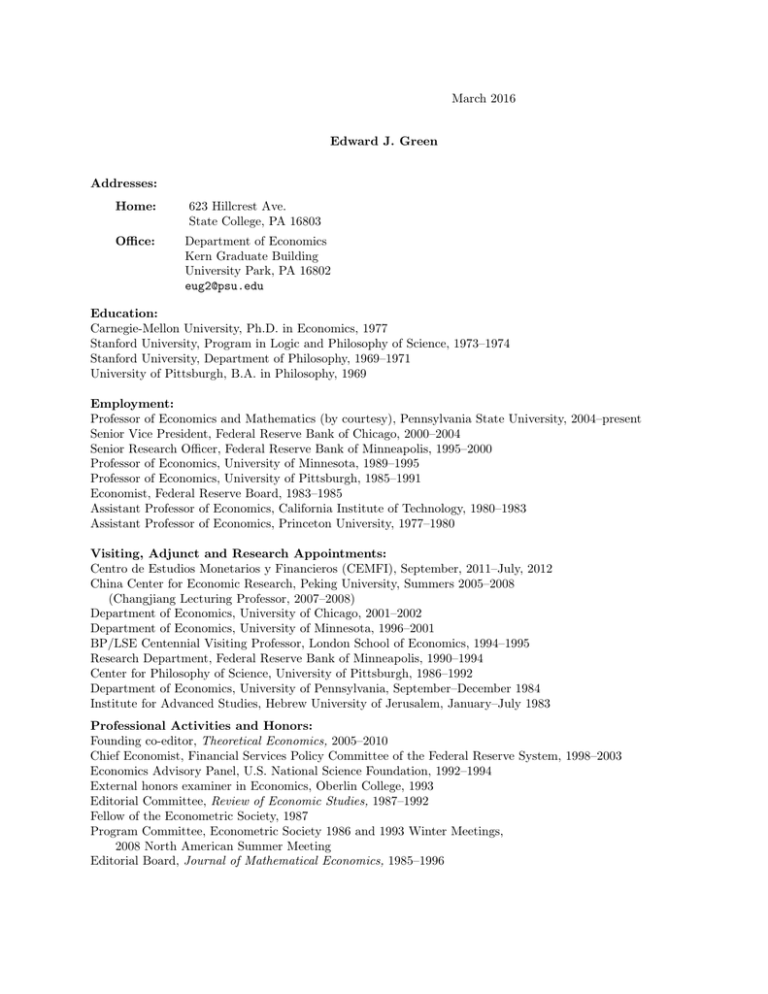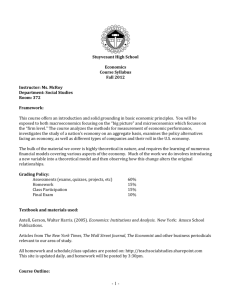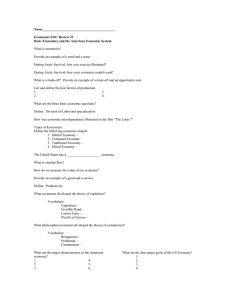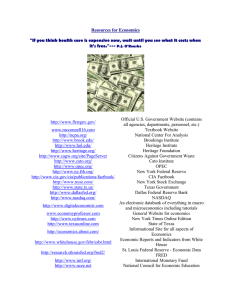March 2016 Edward J. Green Addresses: Home:
advertisement

March 2016 Edward J. Green Addresses: Home: 623 Hillcrest Ave. State College, PA 16803 Office: Department of Economics Kern Graduate Building University Park, PA 16802 eug2@psu.edu Education: Carnegie-Mellon University, Ph.D. in Economics, 1977 Stanford University, Program in Logic and Philosophy of Science, 1973–1974 Stanford University, Department of Philosophy, 1969–1971 University of Pittsburgh, B.A. in Philosophy, 1969 Employment: Professor of Economics and Mathematics (by courtesy), Pennsylvania State University, 2004–present Senior Vice President, Federal Reserve Bank of Chicago, 2000–2004 Senior Research Officer, Federal Reserve Bank of Minneapolis, 1995–2000 Professor of Economics, University of Minnesota, 1989–1995 Professor of Economics, University of Pittsburgh, 1985–1991 Economist, Federal Reserve Board, 1983–1985 Assistant Professor of Economics, California Institute of Technology, 1980–1983 Assistant Professor of Economics, Princeton University, 1977–1980 Visiting, Adjunct and Research Appointments: Centro de Estudios Monetarios y Financieros (CEMFI), September, 2011–July, 2012 China Center for Economic Research, Peking University, Summers 2005–2008 (Changjiang Lecturing Professor, 2007–2008) Department of Economics, University of Chicago, 2001–2002 Department of Economics, University of Minnesota, 1996–2001 BP/LSE Centennial Visiting Professor, London School of Economics, 1994–1995 Research Department, Federal Reserve Bank of Minneapolis, 1990–1994 Center for Philosophy of Science, University of Pittsburgh, 1986–1992 Department of Economics, University of Pennsylvania, September–December 1984 Institute for Advanced Studies, Hebrew University of Jerusalem, January–July 1983 Professional Activities and Honors: Founding co-editor, Theoretical Economics, 2005–2010 Chief Economist, Financial Services Policy Committee of the Federal Reserve System, 1998–2003 Economics Advisory Panel, U.S. National Science Foundation, 1992–1994 External honors examiner in Economics, Oberlin College, 1993 Editorial Committee, Review of Economic Studies, 1987–1992 Fellow of the Econometric Society, 1987 Program Committee, Econometric Society 1986 and 1993 Winter Meetings, 2008 North American Summer Meeting Editorial Board, Journal of Mathematical Economics, 1985–1996 Irving Fisher Monograph Award, 1980 Publications: Noncooperative price taking in large dynamic markets. Journal of Economic Theory, 22(2):155–82, April 1980. Equilibrium and efficiency under pure entitlement systems. Public Choice, 39(1):185–212, 1982. Noncooperative collusion under imperfect price information. with Robert H. Porter. Econometrica, 52(1):87– 100, January 1984. On the difficulty of eliciting summary information. Journal of Economic Theory, 32(2):228–45, April 1984. Continuum and finite-player noncooperative models of competition. Econometrica, 52(4):975–94, July 1984. Financial futures and price-level variability. In Financial Options and Futures in the U.S. Economy. Federal Reserve Board, 1986. Lending and the smoothing of uninsurable income. In Edward C. Prescott and Neil Wallace, eds., Contractual Arrangements for Intertemporal Trade. Minnesota Studies in Macroeconomics series, vol. 1, Minneapolis: University of Minnesota Press, 1987. Classical statistics as a theory of incentives. Games and Economic Behavior, 2(1):13–28, March 1990. Can a ‘credit crunch’ be efficient? with Soo Nam Oh. Federal Reserve Bank of Minneapolis Quarterly Review, 15(4):3–17, Fall 1991. Contracts, constraints and consumption. with Soo Nam Oh. Review of Economic Studies, 58(5):883–99, October 1991. A revealed preference theory for expected utility. with Kent Osband. Review of Economic Studies, 58(4):677– 96, July 1991. Eliciting traders’ knowledge in a frictionless asset market. In B. Dutta et al., eds., Game Theory and Economic Applications: Proceedings, New Delhi, India, December 1990, Springer Lecture Notes in Economics and Mathematical Systems #389, 1992. On the emergence of parliamentary government: The role of private information. Federal Reserve Bank of Minneapolis Quarterly Review, 17(1):2–16, Winter 1993. Privatization, the entrepreneurial sector, and growth in post-COMECON economies. Journal of Comparative Economics, 17(2):407–17, June 1993. The reorientation of neoclassical demand theory. with Keith Moss. In A. Janis and T. Horowitz, eds., Scientific Failure, Rowman and Littlefield, 1994. Will the new $100 bill decrease counterfeiting? with Warren E. Weber. Federal Reserve Bank of Minneapolis Quarterly Review, 20(3):3–10, Summer 1996. Bayes contingent plans. with In Uck Park. Journal of Economic Behavior and Organization, 31(2):225–36, November 1996. Money and debt in the structure of payments. Monetary and Economic Studies, 15(1):63–87, May 1997. A rudimentary random-matching model with divisible money and prices. with Ruilin Zhou. Journal of Economic Theory, 81(2):252–71, August 1998. Diamond and Dybvig’s classic theory of financial intermediation: What’s missing? with Ping Lin. Federal Reserve Bank of Minneapolis Quarterly Review, 24(1):3–13, Winter 2000. Thoughts on the Fed’s role in the payments system. with Richard M. Todd. Federal Reserve Bank of Minneapolis Quarterly Review, 25(1):12–27, Winter 2001. Financial-intermediation regime and efficiency in a Boyd-Prescott economy. with Yeong Yuh Chiang. Carnegie Rochester Conference Series on Public Policy, 54:117–29, June 2001. Central banking and the economics of information. Federal Reserve Bank of Chicago Economic Perspectives, 25(2):28–37, 2nd Quarter 2001. Clearing and settling financial transactions, Circa 2000. In Modern Central Banking, A. Santomero, S. Viotti, and A. Vredin, eds., Kluwer Academic Publishers, 2001. Payment arrangements and inflation. American Economic Review, 92(2):51–57, May 2002. Dynamic monetary equilibrium in a random matching economy. with Ruilin Zhou. Econometrica, 70(3):929– 69, May 2002. Economic perspective on the political history of the Second Bank of the United States. Federal Reserve Bank of Chicago Economic Perspectives, 27(1):59–67, 1st Quarter 2003. Implementing efficient allocations in a model of financial intermediation. with Ping Lin. Journal of Economic Theory, 109(1):1–23, March 2003. Formulating the imputed cost of equity capital for priced services at Federal Reserve banks. with Jose A. Lopez, and Zhenyu Wang. Federal Reserve Bank of New York Economic Policy Review, 9(3):55–81, September 2003. A review of Interest and Prices: Foundations of a Theory of Monetary Policy. by Michael Woodford. Journal of Economic Literature, 43(1):121–34, March 2005. Money as a mechanism in a Bewley economy. with Ruilin Zhou. International Economic Review, 46(2):351– 71, May 2005. Incentive-efficient risk sharing in a settlement mechanism. with Hiroshi Fujiki and Akira Yamazaki. Journal of Economic Theory, 142(1):178–195, September 2008. Heterogeneous producers facing common shocks: an overlapping-generations example. Journal of Economic Theory, 144(6):2266–2276, November, 2009. Perfectly competitive bilateral exchange without discounting. with Ruilin Zhou. Journal of Monetary Economics, 57(2):121–131, March, 2010. Bailouts. Federal Reserve Bank of Richmond Economic Quarterly, 96(1):11–32, First Quarter, 2010. Embedding an analytic relation in the transitive closure of a Borel relation. Journal of Logic and Analysis, 5(4):1–10, 2013. Tacit Collusion in Oligopoly. with Robert C. Marshall and Leslie M. Marx. In Roger D. Blair and D. Daniel Sokol eds., Oxford Handbook on International Antitrust Economics, Vol. 2, Oxford University Press, 2015. Necessary and sufficient conditions for dynamic optimization. with A. Kerem Çosar. Macroeconomic Dynamics, 20(3), 2016.




